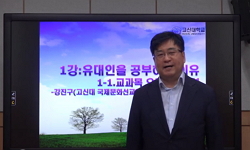Even before its release, Munich caused hot controversies among the movie critics, who were polarized into two camps: one criticized the movie for its alleged attitude of ‘moral equivalence’ towards the Palestinian terrorists and the Israeli counte...
http://chineseinput.net/에서 pinyin(병음)방식으로 중국어를 변환할 수 있습니다.
변환된 중국어를 복사하여 사용하시면 됩니다.
- 中文 을 입력하시려면 zhongwen을 입력하시고 space를누르시면됩니다.
- 北京 을 입력하시려면 beijing을 입력하시고 space를 누르시면 됩니다.

분쟁서사 <뮌헨>에 나타난 인종적 재현 연구 = On the Racial Representation of the Israel-Palestine Conflicts in Munich
한글로보기부가정보
다국어 초록 (Multilingual Abstract)
Even before its release, Munich caused hot controversies among the movie critics, who were polarized into two camps: one criticized the movie for its alleged attitude of ‘moral equivalence’ towards the Palestinian terrorists and the Israeli counter-terrorists while the other praised it for its unbiased treatment of the two antagonistic groups. This paper assesses the current criticism on this movie by examining the racial representations of the two ethnic groups. It also analyzes the various methods by which the director tries to ‘re-humanize’ the often-demonized two parties. Although the humanity of Palestinian terrorists as well as that of the Israelis is emphasized in this movie, the emphasis itself is very much lopsided. The movie ends up successfully constructing the image of a nonconformist, diasporic Jew, which, this paper argues, not only constitutes its forte but also its limitation. This cinematic maneuver can be regarded as a great achievement in that it articulates a dissident voice within the supposedly homogeneous political entity of the Israeli Jews. At the same time, it runs the risk of undermining, or even foreclosing, possible critiques of the state terrorism of Israel by emphasizing a ‘reformed’ conscientious Jewish subject. What makes the matter worse is that the political insights into the history of the territorial issue, as soon as they surface, are drowned due to the shift of the cinematic focus from the politics of (counter-) terrorism to the psychological and moral dimensions typical of morality plays.
참고문헌 (Reference)
1 Brooks, David, "What ‘Munich’ Left Out"
2 Sherman, Gary, "Wanted: Dead or Alive"
3 Jonas, George, "Vengeance: The True Story of an Israeli Counte-Terrorist Team" Simon & Shuster 1984
4 Sieman, Henry, "The Killing Equation" The New York Review of Books
5 Glieberman, Owen, "The Killer Elite" 855 : 58-59, 2005
6 Anderson, Michael, "Sword of Gideon"
7 Brownfeld, Alan C, "Spielberg’s ‘Munich’ Continues to Stir Debate, Soul-Searching about Israel Policies" 25 (25): 56-57, 2006
8 Shoenfeld, Gabriel, "Spielberg’s ‘Munich"
9 Abu-Assad, Hani, "Paradise Now"
10 Said, Edward, "Orientalism" Random House 1979
1 Brooks, David, "What ‘Munich’ Left Out"
2 Sherman, Gary, "Wanted: Dead or Alive"
3 Jonas, George, "Vengeance: The True Story of an Israeli Counte-Terrorist Team" Simon & Shuster 1984
4 Sieman, Henry, "The Killing Equation" The New York Review of Books
5 Glieberman, Owen, "The Killer Elite" 855 : 58-59, 2005
6 Anderson, Michael, "Sword of Gideon"
7 Brownfeld, Alan C, "Spielberg’s ‘Munich’ Continues to Stir Debate, Soul-Searching about Israel Policies" 25 (25): 56-57, 2006
8 Shoenfeld, Gabriel, "Spielberg’s ‘Munich"
9 Abu-Assad, Hani, "Paradise Now"
10 Said, Edward, "Orientalism" Random House 1979
11 Medved, Michael, "Munich’ distorts history" USA Today
12 Spielberg, Steven, "Munich. Perf"
13 Fox, Michael, "Israeli-Palestinian cycle of violence gets the Spielberg treatment"
14 Schickel, Richard, "His ‘Prayer for Peace" Time
15 Nieland, Justus, "Everybody’s Noir Humanism: Chester Himes, Lonely Crusade, and the Quality of Hurt" 43 (43): 225-231, 2009
16 Kushner, Tony, "Defending ‘Munich’ to My Mishpocheh" Los Angeles Times
17 Dabashi, Hamid, "Brown Skin, White Masks" Pluto 2011
18 Shaheen, Jack G, "Arabs and Muslims in Hollywood’s ‘Munich’ and ‘Syriana" 25 (25): 73-, 2006
19 Graham, William A, "21 Hours at Munich"
동일학술지(권/호) 다른 논문
-
죄 없는 K는 악몽의 미로를 어떻게 빠져나올 수 있을 것인가: 오손 웰즈의 영화 <심판>과 카프카의 소설 『심판』의 비교분석
- 문학과영상학회
- 최진성
- 2013
- KCI등재
-
파괴 의지로서의 죽음 본능 탐색—<실비아>와 『종 항아리』의 실비아 플라스와 에스더 그린우드의 사례를 중심으로
- 문학과영상학회
- 임정명
- 2013
- KCI등재
-
- 문학과영상학회
- 이상민
- 2013
- KCI등재
-
- 문학과영상학회
- 이호걸
- 2013
- KCI등재
분석정보
인용정보 인용지수 설명보기
학술지 이력
| 연월일 | 이력구분 | 이력상세 | 등재구분 |
|---|---|---|---|
| 2026 | 평가예정 | 재인증평가 신청대상 (재인증) | |
| 2020-01-01 | 평가 | 등재학술지 유지 (재인증) |  |
| 2019-08-06 | 학회명변경 | 영문명 : Korean Association Of Literature And Film -> The Korean Association Of Literature and Film |  |
| 2017-01-01 | 평가 | 등재학술지 유지 (계속평가) |  |
| 2013-01-01 | 평가 | 등재학술지 유지 (등재유지) |  |
| 2010-01-01 | 평가 | 등재학술지 유지 (등재유지) |  |
| 2008-01-01 | 평가 | 등재학술지 유지 (등재유지) |  |
| 2005-01-01 | 평가 | 등재학술지 선정 (등재후보2차) |  |
| 2004-01-01 | 평가 | 등재후보 1차 PASS (등재후보1차) |  |
| 2003-01-01 | 평가 | 등재후보학술지 선정 (신규평가) |  |
학술지 인용정보
| 기준연도 | WOS-KCI 통합IF(2년) | KCIF(2년) | KCIF(3년) |
|---|---|---|---|
| 2016 | 0.17 | 0.17 | 0.2 |
| KCIF(4년) | KCIF(5년) | 중심성지수(3년) | 즉시성지수 |
| 0.23 | 0.26 | 0.491 | 0.04 |




 ScienceON
ScienceON KISS
KISS






